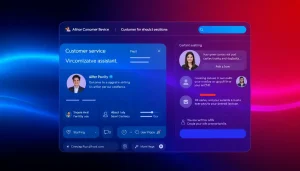Enhancing the Mortgage Process with AI: Efficiency, Precision, and Personalization
Understanding the Mortgage Process with AI
The mortgage industry is experiencing a seismic shift as artificial intelligence (AI) transforms traditional practices into streamlined operations. The mortgage process with AI is not merely a trend; it’s an innovation that promises to reshape the landscape of lending. From automating tedious tasks to delivering personalized solutions, AI’s integration into the mortgage process is enhancing efficiency, reducing human error, and providing a superior customer experience.
What is AI in Mortgage Processing?
AI in mortgage processing refers to utilizing advanced algorithms and machine learning tools to automate and improve various functions within the mortgage lifecycle. This encompasses everything from initial loan applications and credit assessments to underwriting and post-closing processes. AI technologies analyze vast datasets, enabling lenders to make more informed decisions quickly. Through techniques like natural language processing (NLP) and deep learning, AI can learn from past data to predict future outcomes, thereby supporting lenders in making sound financial judgments.
Benefits of Integrating AI in Loans
The integration of AI in the mortgage process offers numerous advantages:
- Increased Efficiency: Automating repetitive tasks allows lenders to focus on strategic areas, significantly speeding up the loan approval process.
- Enhanced Accuracy: AI algorithms minimize human errors in data entry and analysis, ensuring that the applications and underwriting processes are thorough and precise.
- Cost Reduction: By streamlining operations and reducing the time needed for processing loans, lenders can cut operational costs, which can potentially be passed onto borrowers in the form of lower fees.
- Personalized Borrower Experience: AI helps in tailoring products and services to meet individual borrower needs, enhancing customer satisfaction.
Common AI Technologies Used
Several AI technologies are shaping the mortgage landscape:
- Robotic Process Automation (RPA): RPA handles repetitive tasks such as data entry and document management efficiently.
- Machine Learning: This technology enables systems to learn from data patterns, making predictions about creditworthiness and risk assessment.
- Natural Language Processing: NLP assists in processing and understanding unstructured data, such as borrower inquiries and feedback.
- Optical Character Recognition (OCR): OCR technology allows for quick processing of physical documents by converting them into digital data that can be analyzed by AI systems.
How AI is Reshaping Loan Applications
Automated Document Verification
One of the most significant advancements powered by AI is automated document verification. Utilizing OCR and machine learning, AI systems can quickly and accurately verify documents such as income statements, tax forms, and identity proofs. This saves considerable time in the underwriting phase, allowing lenders to focus on more complex issues like risk assessment and customer service.
Reducing Processing Times with AI
The application processing time has historically been one of the most criticized aspects of the mortgage industry. AI significantly reduces this time by automating manual processes. For instance, algorithms can analyze applicant data and relevant economic indicators, thus speeding up credit evaluations. According to recent studies, some lenders have reported processing times decreasing by up to 50%, enabling quicker approvals and improved borrower satisfaction.
Personalized Solutions for Borrowers
AI holds the potential to deliver personalized mortgage solutions. By analyzing a borrower’s financial history, preferences, and behavior, AI systems can suggest loan products that best suit their needs. This hyper-personalization not only enhances the borrower experience but also fosters loyalty and trust in lenders.
AI Tools Streamlining the Mortgage Process
Popular AI Platforms for Lenders
Many AI platforms have emerged as valuable tools for lenders, enabling them to harness the power of AI in their operations. Platforms like Ellie Mae’s Encompass and Blend facilitate loan origination and processing by providing integrated solutions that manage everything from initial applicant engagement to closing documents.
Case Studies of Successful Implementations
Examining case studies provides insights into how lenders effectively integrate AI:
- Rocket Mortgage: This company revolutionized online mortgage processes by automating speed and accuracy through AI-driven underwriting systems, resulting in one of the fastest approvals in the industry.
- Better.com: Their platform leverages AI to reduce the time spent on paperwork and validations, allowing them to close loans faster and at a lower cost compared to traditional lenders.
Integrating AI into Existing Systems
For many institutions, the challenge lies in effectively integrating AI into their existing systems. This may involve:
- Data Cleanup: Before integrating AI, financial institutions must ensure their data is accurate and relevant, which often requires extensive data cleanup.
- Training Staff: Employees need to be equipped with the necessary skills to work alongside AI tools. Continuous education is fundamental to a smooth transition.
- Partnerships with Tech Firms: Collaborating with technology firms specializing in AI can streamline the integration process and provide expertise that some institutions lack.
Challenges and Considerations for AI in Mortgages
Addressing Privacy Concerns
As AI systems handle sensitive personal data, privacy concerns are paramount. Lenders must ensure their AI systems are compliant with regulations such as the General Data Protection Regulation (GDPR) and the California Consumer Privacy Act (CCPA). Implementing transparent data usage policies and ensuring robust security measures are vital steps in mitigating these concerns.
Balancing AI and Human Interaction
While AI automates several processes, maintaining human interaction remains essential. Mortgages are significant financial commitments that often require empathy and understanding. Lenders should focus on systems that augment human capabilities rather than replace them, ensuring a balanced approach between AI efficiency and human touch.
Regulatory Compliance in AI Adoption
As AI technologies evolve, so too do the regulatory frameworks governing their use. Staying abreast of changes is crucial for lenders. Regular audits of AI systems for compliance, bias, and fairness can help institutions navigate these complex regulations and safeguard their operations.
The Future of Mortgages: AI and Beyond
Emerging Trends in AI Mortgage Processing
The future of the mortgage industry is undoubtedly linked to the advancements of AI. Emerging trends include:
- Enhanced Decision-Making: As AI systems improve their data processing capabilities, lenders will rely more on AI for decisions regarding loan products and borrower qualification.
- Increased Use of Blockchain: Blockchain technology may work alongside AI to enhance security, increase transparency, and streamline transactions.
- Convergence with Other Technologies: The integration of AI with technologies such as augmented reality (AR) and the Internet of Things (IoT) to offer innovative mortgage solutions is on the horizon.
Impact of AI on Mortgage Brokers and Agents
The role of mortgage brokers and agents is evolving in light of AI technology. While some tasks may be automated, professionals in this sector will need to adapt by focusing on client relationships, advisory roles, and complex problem-solving that AI cannot replicate. Forward-looking agents will use AI as a tool to enhance their service offerings, providing clients with better insights and personalized recommendations.
Preparing for an AI-Driven Mortgage Market
To thrive in an emerging AI-driven mortgage market, institutions must invest in technology, training, and resources. This involves:
- Developing an AI Strategy: Institutions need a clear strategy about how they plan to integrate AI technologies within the existing framework.
- Engaging Stakeholders: Involving all stakeholders, including employees, customers, and regulatory bodies, is crucial for successful implementation.
- Continuous Learning: Encouraging a culture of innovation and learning will equip teams to respond to rapidly evolving technology and consumer expectations.
Conclusion
The mortgage process with AI is an exciting frontier that promises to enhance efficiency, reduce processing times, and improve borrower experiences. While challenges exist, the benefits are substantial. By embracing AI technology, lenders can not only streamline their operations but also position themselves as leaders in a fast-evolving market, ready to meet the needs of the next generation of borrowers.













Post Comment